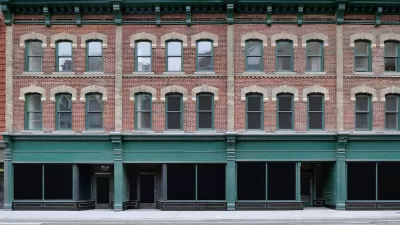In comparing data collected during the 2010 Census, walkable neighborhoods are shown to have greater vacancy rates than the cities they're in.
This post from Cubit Planning's Kristen Carney explores the numbers, which went against her own assumptions.
"I hypothesized that a socially redeeming characteristic of walkable neighborhoods would be a lower than average vacancy rate. More people buying property in walkable neighborhoods means more real estate taxes–which fund our public services. And haven't we all been reading articles about how Gen Y loves living in dense urban areas, and how 58 percent of American would prefer to live in a neighborhood where stores are within an easy walk?
Well, the Census 2010 data indicate that walkable neighborhoods have higher vacancy rates than their surrounding cities. Only Dupont Circle in DC and City Center East in Philadelphia have slightly lower vacancy rates than their surrounding cities. Every other walkable neighborhood had a higher vacancy rate than its surrounding city. Topping the chart is Core in San Diego with a vacancy rate of 24.6% while San Diego city has a vacancy rate of 6.4%."
FULL STORY: Walkable Neighborhoods have Higher Housing Vacancy Rates per Census 2010 Data

Study: Maui’s Plan to Convert Vacation Rentals to Long-Term Housing Could Cause Nearly $1 Billion Economic Loss
The plan would reduce visitor accommodation by 25,% resulting in 1,900 jobs lost.

North Texas Transit Leaders Tout Benefits of TOD for Growing Region
At a summit focused on transit-oriented development, policymakers discussed how North Texas’ expanded light rail system can serve as a tool for economic growth.

Why Should We Subsidize Public Transportation?
Many public transit agencies face financial stress due to rising costs, declining fare revenue, and declining subsidies. Transit advocates must provide a strong business case for increasing public transit funding.

How to Make US Trains Faster
Changes to boarding platforms and a switch to electric trains could improve U.S. passenger rail service without the added cost of high-speed rail.

Columbia’s Revitalized ‘Loop’ Is a Hub for Local Entrepreneurs
A focus on small businesses is helping a commercial corridor in Columbia, Missouri thrive.

Invasive Insect Threatens Minnesota’s Ash Forests
The Emerald Ash Borer is a rapidly spreading invasive pest threatening Minnesota’s ash trees, and homeowners are encouraged to plant diverse replacement species, avoid moving ash firewood, and monitor for signs of infestation.
Urban Design for Planners 1: Software Tools
This six-course series explores essential urban design concepts using open source software and equips planners with the tools they need to participate fully in the urban design process.
Planning for Universal Design
Learn the tools for implementing Universal Design in planning regulations.
City of Santa Clarita
Ascent Environmental
Institute for Housing and Urban Development Studies (IHS)
City of Grandview
Harvard GSD Executive Education
Toledo-Lucas County Plan Commissions
Salt Lake City
NYU Wagner Graduate School of Public Service





























